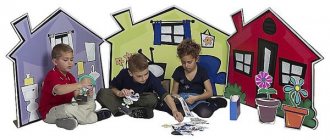Development of communication of a younger preschooler in play activities
Definition 1
Communication is the process of establishing contacts between people, necessary for them to carry out joint activities and establish friendly and other relationships.
Communication skills begin to develop from a child’s early age. Their formation is necessary for the social formation and development of the personality of a preschooler.
Children begin to develop communication skills through play activities. This is due to the fact that play is the leading activity of a preschooler and helps him master the basics of the structure of the world around him.
Figure 1. Communication of preschoolers. Author24 - online exchange of student work
Are you an expert in this subject area? We invite you to become the author of the Directory Working Conditions
At primary school age, a child’s communication with peers has its own characteristics. They are due to the fact that the child does not yet master the basics of cultural behavior and does not know the norms of social communication. You can get acquainted with them through the game.
Playful activities help children develop joint activity skills, establish the basics of interaction in a team, eliminate the child’s isolation, remove his embarrassment in establishing social contacts and develop skills for positive contact with peers.
The play activities of younger preschoolers, aimed at developing the child’s communication skills, should be based on compliance with a number of conditions:
- The gameplay should be free from evaluation. You cannot evaluate gaming successes or failures. This turns the game into a competition. The child loses the connection between his activities and his peers and strives to act one way and not another in order to receive a positive assessment from an adult. Therefore, grades need to be removed in order to develop a sense of collective community, a common direction in the activities of preschoolers.
- Building a story game or educational game without using toys. Toys distract the child’s attention from joint activities and from communicating with other participants in the game.
- Elimination of competitive moments in the gameplay. At primary school age, it is necessary to use games that maximally focus the child on joint collective activities. Contests and competitions lead to collective disunity.
Finished works on a similar topic
Course work Features of communication of preschool children in play activities 470 ₽ Abstract Features of communication of preschool children in play activities 220 ₽ Examination Features of communication of preschool children in play activities 190 ₽
Receive completed work or specialist advice on your educational project Find out the cost
MAGAZINE Preschooler.RF
Consultation on the topic: “Real and role relationships and interactions of children in play activities”Compiled and conducted by teacher Filina N.A. Serpukhov, March 2017 Municipal preschool educational institution, combined kindergarten No. 29 “Bee”
Preschool childhood is a short but important period of personality development. During these years, the child acquires initial knowledge about the life around him, he begins to form a certain attitude towards people, towards work, develops skills and habits of correct behavior, and develops a character.
The whole life of a preschool child is permeated with play; this is the only way he is ready to open himself to the world and the world for himself. Game is one of the main forms of organizing the process of education, training and development in kindergarten.
Role-playing game is a creative game of preschool children in a developed form, representing an activity in which children take on the roles of adults and, in a generalized form, in specially created game conditions, reproduce the activities of adults and the relationships between them.
Role-playing play plays a leading role in the formation of positive relationships among children and the formation of positive moral qualities of an individual of senior preschool age. In the process of role-playing games, conditions are created for further strengthening the moral ideas, feelings, and qualities of children that were formed in everyday life.
In play, a child learns to subordinate his behavior to the rules of the game, learns the rules of communication with people, develops his mental abilities and cognitive interests, which are especially important for successful learning at school. Playing for a child is a serious activity.
The game has basic structural elements: game concept; plot, content; game actions; roles; rules that are dictated by the game itself and are created by children or proposed by adults. These elements are closely interrelated.
Game design is a general definition of what and how children will play.
A plot is a series of events united by vitally motivated connections. The plot determines the development, diversity and interconnection of play actions and relationships between children.
The plot reveals the content of the game - the interconnection of game actions, the relationships between children. The content of the game makes it attractive, arouses interest and desire to play. In terms of content, the games of children of primary preschool age differ from the games of older children. These differences are associated with experience, features of the development of imagination, thinking, and speech.
Playful activities help children realize their chosen roles.
The role is the main core of the role-playing game. Most often, the child takes on the role of an adult. The presence of a role in the game means that in his mind the child identifies himself with this or that person and acts in the game on his behalf, using certain objects accordingly (drives a car like a driver; sets a thermometer like a nurse), enters into a variety of relationships with other players (punishes or caresses the daughter, examines the patient, etc.). The role is expressed in actions, speech, facial expressions, pantomime.
During the game, children set the rules themselves (in some games, an adult), thereby determining and regulating the behavior and relationships of the players. They give games organization and stability, consolidate their content and determine further development, the complication of relationships and relationships. At the same time, the rules help timid, shy children to be active participants in the game.
All of these structural game elements are more or less typical, but they have different meanings and are related differently in different types of games.
There are two types of relationships in the game - game (role-playing) and real.
Game relationships reflect relationships in plot and role. So, if a child has taken on the role of Karabas-Barabas, then, in accordance with the plot, he will be exaggeratedly angry towards children who have taken on the roles of other characters in A. Tolstoy’s fairy tale “The Adventures of Pinocchio, or the Golden Key” .
Game (role) relationships determine the choice and distribution of roles and are manifested in a variety of remarks, comments, and requirements that regulate the course of the game. The distribution of roles is an important point in the emergence of a game. Often, a child leader imposes uninteresting roles on his comrades, while he himself takes on the most attractive one, regardless of the wishes of others. If the children fail to agree on the distribution of roles, then the game falls apart or one of the children leaves it.
The older the child, the more pronounced his desire to play together with his peers, the more inclined he is to agree to perform an unattractive role just for the sake of joining a play group. He restrains his personal desires and submits to the demands of other children. When choosing partners for joint games, preschoolers rely on their sympathies, highlight moral qualities and gaming skills that are valued in their peers. It is of no small importance that a peer has attractive game items.
The second type of relationships that arise in the game are real relationships. Real relationships often contradict game ones. The older the child, the more often the conflict between role and real relationships is resolved in favor of the latter. Real relationships in the game are no less important than role-playing ones. Real relationships in role-playing games also take place when the child temporarily leaves the role and gives instructions to the other regarding the further course of the game and compliance with the rules.
Every now and then the child seems to step out of his role and become himself for a few seconds. For example, the “seller” suddenly changes his emphatically polite tone in dealing with the “buyers” and begs the children: “Well, don’t take everything, otherwise I won’t have anything left in the store” or “As soon as you eat the apples, bring them back to me, otherwise there will be nothing to sell . Sometimes this exit from the role is determined by the need to agree on something with comrades. “Well, what are you talking about,” Vova waves his hand at Ira and Valya, who are running to meet the flowers of their “pilot dad,” “I’m still in the sky, I haven’t arrived yet.”
In some cases, children point out to each other violations of the rules of behavior inherent in one or another role taken by the partner.
Real relationships are the relationships between children as partners, comrades doing a common task. They can agree on the plot, the distribution of roles, and discuss questions and misunderstandings that arise during the game. In play activities, certain forms of communication between children arise. The game requires from the child such qualities as initiative, sociability, and the ability to coordinate his actions with the actions of a group of peers in order to establish and maintain communication.
Let us consider step by step how relationships between children arise and develop.
Elements of communication appear very early (two or three years), when children do not yet know how to build a story-based game, but each plays on his own. As a rule, the stimulus for play is a toy or object. During this period of play development, the child is focused on his own actions and pays little attention to the actions of another child. However, from time to time the baby begins to look at how the other child is playing. Interest in a peer's game leads to attempts to establish certain relationships. From this we can conclude that the first forms of relationships are manifested in the child’s desire to get closer to another, to play next to him. Such contacts do not yet change the essence of the game - each child plays on his own.
At the next stage (three to four years), the first interaction between children occurs based on the use of a common toy. The child begins to communicate more intensively with his peers. He is actively looking for reasons for joint activities and for establishing relationships. The duration of communication in this case depends on the extent to which the child has mastered the playful use of objects and the ability to create and implement a play plan. During the period when play consists only of performing the most basic actions with toys (rolling a car by a rope, pouring sand from a bucket), the child’s interaction with a peer is short-term. The content of the game does not yet provide grounds for sustainable communication. At this stage, children can exchange toys and help each other (one can rush to help the other correctly position the overturned car, and the other will accept this service). The game can already unite 2-3 people.
With the development of gaming skills and the complication of play plans, children (five to six years old) begin to engage in longer-term communication. The game itself demands this and promotes this. Penetrating deeper into the life of adults, the child discovers that this life constantly takes place in interaction with other people (mom talks to dad, serves the family dinner, monitors the behavior of children at the table; a salesman serves customers; a doctor treats the sick, a sister helps him, etc. d.) The desire to reproduce adult relationships in play leads to the fact that the child begins to need partners who would play with him. Hence the need arises to come to an agreement with other children and organize a game together that includes several roles.
In playing together, children learn the language of communication, learn to coordinate their actions with the actions of others, learn mutual understanding and mutual assistance.
Bringing children together to play together helps to further enrich and complicate the content of games. Each child's experience is limited (he is familiar with a relatively narrow range of actions performed by adults). And in the game, an exchange of experience occurs: children adopt each other’s existing knowledge and turn to adults for help. The complication of the content of games leads, in turn, to the complication of real relationships, to an increase in the number of participants in the game, and to the need for clearer coordination of their actions.
With the development of the ability to create a detailed plot plan and plan joint activities, the child comes to the need to find a place among the players and establish connections with them. At the same time, each child learns to behave in accordance with the general situation of the game and the composition of this group of children. Already when entering the game, children discover individual characteristics. One shouts demandingly: “I will be in charge! I!" Some guys will calmly accept this desire. However, there may be someone who will not be satisfied with such a statement. In this case, a conflict arises. A child who is dissatisfied with the distribution of roles may categorically refuse to participate in the game: “I won’t play with you. And that’s it!” But he can also displace the contender for first place: “Come on! Come here everyone! I will command!”
If the children fail to agree among themselves, the game will fall apart. Interest in the game and the desire to participate in it lead to the fact that children make mutual concessions.
The presence of real collective relationships in the game shows that children playing represent a team connected by real connections, acting towards the implementation of a single plan. The subordination of the actions of the members of such a collective is carried out not only due to the roles taken by the children, but also due to the real relationships between the players as members of a single collective. In play, children more easily coordinate their actions, obey and yield to each other, since this is part of the content of the roles they have taken on.
When moving from younger to older ages, real relationships give way more and more space to game ones. In early preschool age, real relationships gradually invade the course of the game; in older preschool age, play relationships completely subordinate real relationships. Real relationships take place when the child temporarily leaves the role and gives instructions regarding the further course of the game and compliance with the rules. Real relationships between children can arise in connection with the game, when children are just negotiating with each other, but they can also occur during the game itself. The real-life relationships that arise around the game often carry over into the relationships defined by the plot of the game. In this case, plot relationships become the form in which real relationships appear.
Real relationships between children may coincide with the possible logic of plot relationships. For example, the initiator of the game of airplanes and traffic controller, by offering this game, himself becomes a traffic controller. In this case, the initiator of the game, by right of his role, gets the opportunity to lead other children in the game itself.
Real relationships between children may not correspond to the logic of plot relationships. For example, the initiator of the game takes on a subordinate role (he portrays one of the planes of the whole squadron) and obeys the child, who plays the role of a traffic controller.
Game relationships can be complicated by real ones if the initiator of the game takes on a subordinate role, but actually continues to lead the game.
| Next > |
Communicative development of a middle preschool child in play
Middle preschool age is a period of transition for a child from communicating with adults to establishing close contacts with peers. The child feels the need to communicate with other children. He loses interest in communicating with adults and wants to find communication partners with similar interests and capabilities.
In middle preschool age, children are united into small groups based on common interests. They build games that are relevant to them and implement them in their narrow circle.
Communication that occurs during the play activities of children of this age contributes to:
- Development of the child’s attention to the communication partner;
- Formation of dialogue building skills;
- Developing skills to attract the attention of a peer who is interesting to the child;
- Development of collective activity skills (in small groups);
- Formation of the foundations of nonverbal communication.
Games help develop preschoolers' communication skills. They relieve children's tension and help eliminate embarrassment.
To develop communication in middle preschool age, games focused on pair work are used: describing each other, building a dialogue, making contact, as well as games to develop teamwork skills: broken phone, round dance, streams, etc.
Relationships between children during games
Share this article:
Children's relationships during games often project the behavioral realities of adults onto themselves. The child acts as a kind of indicator of the older generation. Such manifestations are especially pronounced during play incidents with daughters and mothers, as well as when taking on professional and official powers. Game processes have a beneficial effect on the course of team-friendly relations.
Even at a tender preschool age, various inclinations begin to appear. Such as leadership and organizational skills. From the games it will become clear what temperamental and natural preferences are. It’s easy to detect over-zealousness or over-activity. To find out what qualities are inherent in a child, you just need to take a closer look at the game’s favorites.
It is worth considering that it is typical for infants and children under three years of age not to give away their toys, and also not to get along with other children. It is also necessary to realize that in a large family, socialization occurs faster. An only child can have a more difficult and difficult time getting used to society.





